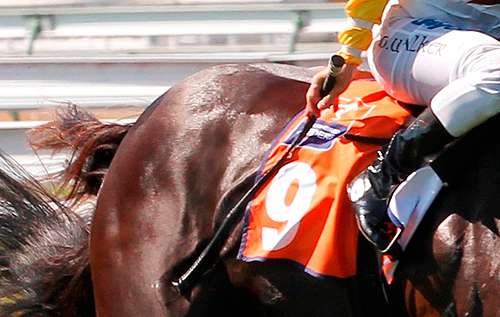Force of backhand whipping brings racehorse rules under further scrutiny

A new study exposes the ineffectiveness of current rules governing racehorse whip use, researchers at the University of Sydney claim.
The study, by researchers at the University's Faculty of Veterinary Science, looks at the force jockeys apply when whipping racehorses with a backhand action.
"Our findings point to a loophole in rules that currently place no limit on the whipping technique that can do the most harm - backhand strikes with the jockey's dominant hand," said Professor Paul McGreevy, lead author of the study published in Journal of Veterinary Behavior.
The study shows that backhand whip strikes, made with the dominant hand, land with more force than forehand strikes.
"Taken in combination with our previous findings that 70 percent of whip impacts are from backhand strikes, and are therefore immune to limits stipulated in the Australian Racing Board (ARB) rules, this report raises further questions about the adequacy of those rules."
The ARB makes a distinction between forehand and backhand whip action. Prior to the final 100 metres of a race, "the whip shall be used in a forehand manner neither in consecutive strides nor on more than five occasions".
"This strongly implies that backhand whip use is less closely scrutinised, which may have profound implications for horse welfare," said Professor McGreevy.
The study used pressure-detection pads to examine the force on impact of whip strikes made by right-handed jockeys.
The results showed that forehand versus backhand action does not influence force on impact when jockeys use their non-dominant hand. However, when using the dominant hand, the jockeys struck with more than 15 percent more force in the backhand than the forehand.
"This result challenges the rules' current focus on forehand whip strikes. It should inform any review of the rules around whip use including its impact on fatigued horses when they are being struck for a perceived sporting gain," Professor McGreevy said.
The results complement previous published papers from the Faculty of Veterinary Science showing that:
- horses, on average, achieve their highest speeds in the 600 to 400 metre section of a race, where there is no whip use
- over half of NSW jockeys hold the whip in their inside (right, dominant) hand, challenging the view that whips are used for steering
- the unpadded section of the whip makes contact in 64 percent of strikes and, contrary to the current Australian Veterinary Association policy, more than 75 percent of whip strikes make contact with the abdomen.
More information: www.journalvetbehavior.com/art … (13)00100-7/abstract
Provided by University of Sydney



















